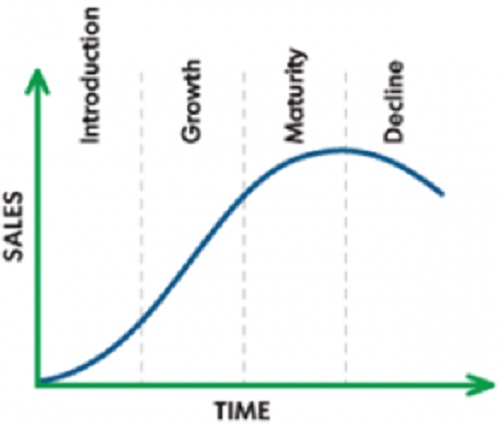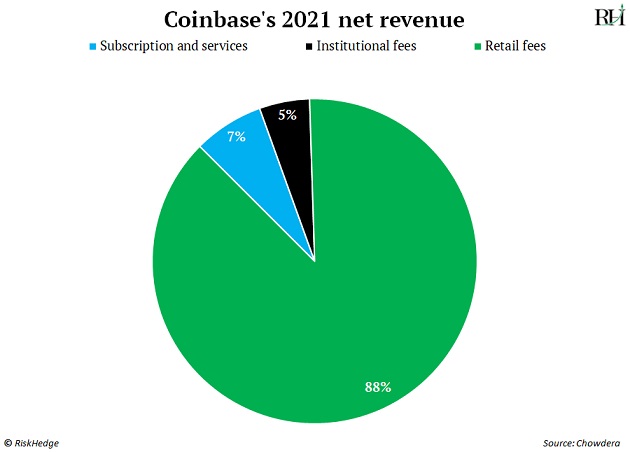
Avoid this disruptor in decline
- Stephen McBride
- |
- July 25, 2022
- |
- Comments
This article appears courtesy of RiskHedge.
I’m blacklisting one of today’s most popular disruptor stocks...
It’s the most popular and well-known crypto company in America.
You’ve surely heard of it… and you may even use it.
And while its stock is down 85%... and seems like a bargain to many investors...
I’m not touching it.
I’ll share why today.
It all has to do with a pattern that plays out time and time again with disruptor stocks.
The same pattern that helped me warn readers to avoid Netflix back in 2018 before it fell 40% in five months.
-
I call it: the lifecycle of disruptive businesses.
Take a look...
As you can see, disruptor stocks go through four distinct phases:
 Source: Business2Community
Source: Business2Community
In their introduction stage, disruptors burst onto the scene with a new product or service and transform the world.
During the growth stage, the world adopts their new invention and revenues skyrocket.
The first two phases are when you can make the most money backing disruptors.
In Netflix’s introduction stage, it disrupted the status quo by selling movies via a subscription model. Instead of making a trip to the local movie rental store, you could have Netflix mail DVDs to you in red paper envelopes.
Then, when high-quality internet became widely available… Netflix turned into a streaming company.
That’s when its growth phase had begun. Customers could watch new movies anytime they wanted, at the touch of a button. No more late fees either.
Movie rental stores like Blockbuster went bankrupt while Netflix’s revenue and user base shot through the roof. Netflix enjoyed one of the most historic growth phases of any disruptive business we’ve ever seen… and its investors enjoyed 12,900% gains from 2007 to NFLX’s peak in 2018.
-
The next stage can be dangerous to your wealth.
Eventually, most groundbreaking technologies become easier to replicate. And competition comes knocking...
This is when disruptors enter the maturity stage.
Like Netflix in 2018.
Serious competitors had already launched their own streaming apps.
Others were gearing up too... like Disney and Apple.
It got harder for Netflix to find new subscribers… and growth tapered off.
Netflix fell 40% in five months after I first told readers to avoid it in July 2018.
Fast forward to today.
Netflix has more competition than ever. There are more than 200 streaming services today!
The once-dominant disruptor is in the decline stage. Its latest earnings report revealed it lost nearly 1 million subscribers last quarter.
Its stock has cratered 75% since last October.
-
Today, I’m warning you about another popular disruptor in its maturity phase.
Crypto exchange Coinbase (COIN) cratered 27% after reporting earnings back in May.
The stock’s down 85% from its November high.
Coinbase is as close as it gets to a “blue chip” crypto stock. It’s widely used, has a respected brand, and has achieved great profitability.
I wanted to see if Coinbase was “undervalued.” Truth is, I expected to find a great opportunity to pick up shares in America’s leading crypto company at bargain basement prices.
So I analyzed it to see which stage of a disruptive business it’s in.
And it became clear this is the next disruptive pioneer to avoid.
Coinbase, like Netflix, was a game-changer...
You see, it was near impossible to buy bitcoin in the early days of crypto. In fact, people did all sorts of risky things to get their hands on bitcoin.
Exchanges didn’t exist, so folks met up in local cafes and handed over physical dollars for USB sticks containing bitcoin.
Coinbase solved all this.
It made buying bitcoin easy—all you needed was a credit card.
This transformed Coinbase from a scrappy startup into a $90 billion giant in less than a decade.
-
For years, Coinbase was the go-to crypto exchange for ordinary investors.
But now it’s facing a ton of strong competition.
You can buy cryptos on Binance, FTX, Gemini, and dozens of other exchanges today. Despite Coinbase getting the jump on all its competitors, it controls just 2% of the market. That’s down from 10% a few years ago.
And it just lost its crown as the exchange holding the most bitcoin. That’s Binance now.
These are classic signs of a disruptor in its maturity phase.
-
Next comes the decline stage.
Coinbase gets 93% of its revenues from commissions. These are the fees you pay when you buy or sell crypto on its website.
Now get this… 88% of those revenues come from trading fees charged to ordinary individual investors, or “retail.”
The other 5% is from the “institutional” commissions. In other words, companies and funds trading crypto on its platform.

But did you know institutions account for 70% of Coinbase’s transactions?
Institutional volumes are more than 2X retail volumes, yet Coinbase generates nearly 18X more revenue from retail.
The reason?
Coinbase whacks individual investors—who don’t know any better—with high fees.
While offering discounts to institutions.
This can’t last.
Dozens of exchanges offer cheaper trading fees, including Coinbase’s own “Pro” website.
If you invest in crypto, I encourage you to check out Coinbase Pro. It’s Coinbase’s trading-oriented app where you can buy cryptos for at least 50% cheaper than on its main platform.
If every retail user switched to Coinbase Pro, Coinbase’s revenues would plunge 45%.
Anyone can sign up for Coinbase Pro—and there is no minimum account size.
I like Coinbase’s service. I use it, and I encourage my crypto subscribers to use it.
But their business model is another story. They’re essentially banking on the ignorance of ordinary investors. It’s a poor long-term strategy.
In short, Coinbase might look cheap after such a steep decline, but don’t be fooled. This is a disruptor in decline.
It’s entered the “bad” stages of the lifecycle of disruptive businesses.
And I don’t see things turning around.
If you still want to buy Coinbase after reading today’s essay, proceed with caution.
Stephen McBride
Editor — Disruption Investor
Stephen McBride is editor of the popular investment advisory Disruption Investor. Stephen and his team hunt for disruptive stocks that are changing the world and making investors wealthy in the process. Go here to discover Stephen’s top “disruptor” stock pick and to try a risk-free subscription.
|

This article appears courtesy of RH Research LLC. RiskHedge publishes investment research and is independent of Mauldin Economics. Mauldin Economics may earn an affiliate commission from purchases you make at RiskHedge.com
